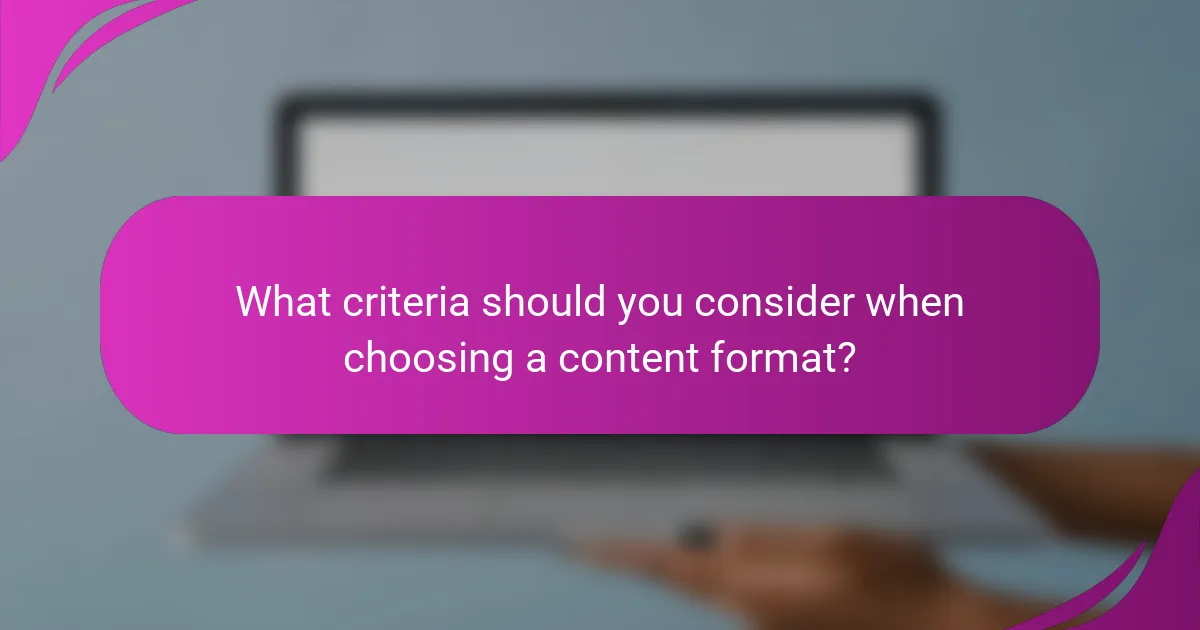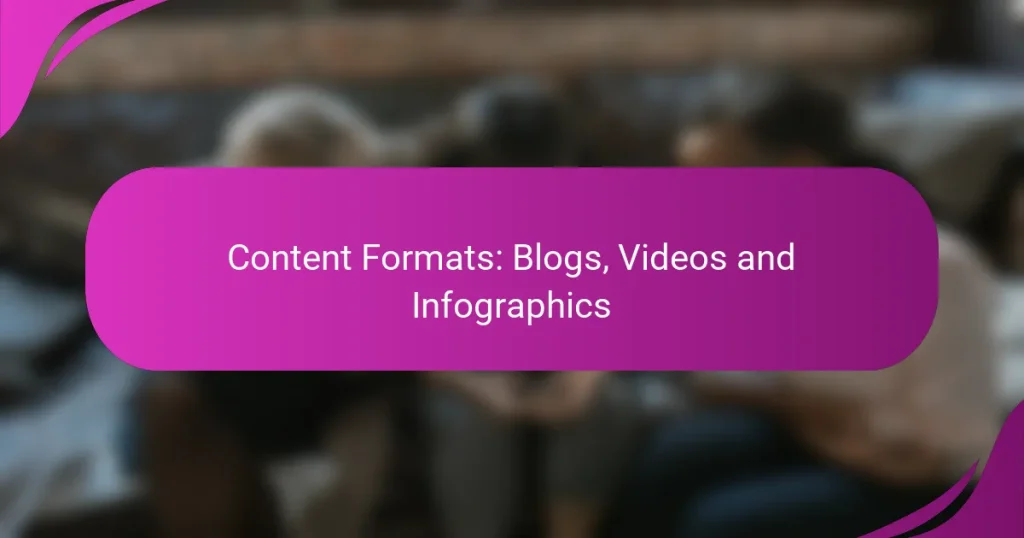In the realm of lead generation in South Africa, blogs, videos, and infographics stand out as powerful content formats. Each format brings unique advantages, from blogs enhancing brand visibility through informative articles to videos engaging audiences with memorable visual storytelling. By leveraging these formats, businesses can effectively attract potential customers and drive them towards conversion.

What are the best content formats for lead generation in South Africa?
The best content formats for lead generation in South Africa include blogs, videos, and infographics. Each format has unique strengths that can effectively attract and engage potential customers, driving them towards conversion.
Blogs for SEO and engagement
Blogs are essential for improving search engine optimization (SEO) and fostering audience engagement. By incorporating relevant keywords and providing valuable information, blogs can rank higher in search results, making it easier for potential leads to find your content.
To maximize the effectiveness of blogs, focus on creating high-quality, informative posts that address common questions or challenges faced by your target audience. Aim for a length of around 1,000 to 2,000 words to provide in-depth coverage while keeping readers engaged.
Videos for higher conversion rates
Videos are highly effective for increasing conversion rates as they can convey information quickly and engagingly. They allow for storytelling and can showcase products or services in action, making it easier for viewers to understand their value.
To leverage videos for lead generation, keep them concise—ideally under three minutes—and include clear calls to action. Consider using platforms like YouTube or social media to reach a broader audience, as video content tends to perform well across these channels.
Infographics for shareability
Infographics are powerful tools for enhancing shareability and visual appeal. They condense complex information into easily digestible visuals, making them more likely to be shared on social media and other platforms.
When creating infographics, focus on clear design and relevant data that resonates with your audience. Use bold colors and concise text to capture attention, and include your branding to ensure your content is recognized when shared.

How do blogs contribute to lead generation?
Blogs play a crucial role in lead generation by attracting potential customers through valuable content and enhancing brand visibility. By providing informative articles, businesses can engage their audience, driving traffic to their websites and ultimately converting visitors into leads.
Improved organic search visibility
Blogs enhance organic search visibility by incorporating relevant keywords and phrases that potential customers are searching for. Regularly updated content signals to search engines that a website is active, which can improve its ranking in search results.
For example, a blog post about “best practices for digital marketing” can attract users searching for that specific topic. This can lead to increased website traffic, as well as higher chances of converting visitors into leads.
Building authority and trust
Consistently publishing high-quality blog content helps establish a brand as an authority in its industry. When potential customers find valuable insights and solutions to their problems, they are more likely to trust the brand and consider its products or services.
To build authority, focus on creating well-researched articles, case studies, and expert interviews. Engaging with readers through comments and social media can further enhance trust and foster a loyal audience.

What are the advantages of using videos?
Videos offer several advantages, including the ability to engage viewers more effectively than text alone. They can convey complex information quickly and are often more memorable, leading to better audience retention and understanding.
Increased audience retention
Videos significantly enhance audience retention by capturing attention through visual and auditory elements. Studies suggest that people retain information presented in video format better than text, with retention rates often exceeding 70% for key messages.
To maximize retention, keep videos concise—ideally under two minutes for promotional content. Use engaging visuals and clear narratives to maintain viewer interest, as longer videos may lead to drop-offs.
Enhanced emotional connection
Videos foster a stronger emotional connection with the audience by combining storytelling with visuals and sound. This multi-sensory approach can evoke feelings and empathy, making the content more relatable and impactful.
Incorporate personal stories or testimonials in your videos to deepen this connection. For example, a brand sharing customer success stories can resonate more with viewers than traditional advertisements, leading to increased loyalty and engagement.

How do infographics enhance content marketing?
Infographics enhance content marketing by presenting complex information in a visually engaging format that is easy to understand. They combine graphics and text to convey data quickly, making them an effective tool for capturing audience attention and improving retention.
Visual appeal and quick comprehension
Infographics are designed to be visually appealing, utilizing colors, images, and layouts that attract viewers. This visual stimulation helps to convey messages rapidly, allowing audiences to grasp key points in a matter of seconds. For instance, a well-designed infographic can summarize a lengthy report in a format that is digestible at a glance.
To maximize visual appeal, consider using a consistent color scheme and clear typography. Avoid clutter by focusing on essential information and using white space effectively. This approach not only enhances comprehension but also encourages sharing on social media platforms.
Effective data presentation
Infographics excel at presenting data in a way that highlights trends and comparisons. By using charts, graphs, and icons, they can simplify complex statistics and make them more relatable. For example, a pie chart can illustrate market share percentages more effectively than a paragraph of text.
When creating infographics, ensure that the data is accurate and sourced from reputable references. Use clear labels and legends to provide context, and consider including a brief narrative to guide viewers through the information. This practice enhances credibility and encourages informed decision-making among your audience.

What criteria should you consider when choosing a content format?
When selecting a content format, it’s essential to consider your target audience’s preferences, your content goals, and the context in which the content will be consumed. Each format—whether it’s a blog, video, or infographic—has unique strengths that can align with different objectives and audience needs.
Target audience preferences
Understanding your target audience’s preferences is crucial in choosing the right content format. For instance, younger demographics may prefer engaging videos on platforms like TikTok or YouTube, while professionals might lean towards informative blogs or detailed infographics. Conducting surveys or analyzing engagement metrics can help identify what formats resonate best with your audience.
Additionally, consider the accessibility of the content. Infographics can be shared easily on social media, while videos may require more bandwidth and time commitment. Tailoring your format to your audience’s habits ensures higher engagement and effectiveness.
Content goals and objectives
Your content goals significantly influence the format you should choose. If your aim is to educate or inform, a detailed blog post or an infographic might be more suitable. Conversely, if you want to entertain or create a strong emotional connection, videos can be more impactful.
It’s also important to consider the complexity of the information being presented. For example, complex data may be better understood through an infographic that visually breaks down the information, while a narrative-driven story might be best suited for a video format. Aligning your content format with your objectives will enhance clarity and engagement.

How can you measure the effectiveness of each format?
To measure the effectiveness of blogs, videos, and infographics, focus on key performance indicators (KPIs) that reflect audience engagement and conversion rates. Each format has unique metrics that can provide insights into how well it resonates with your target audience.
Engagement metrics
Engagement metrics help you understand how users interact with your content. For blogs, consider tracking page views, average time on page, and comments. For videos, metrics like watch time, likes, and shares are crucial, while infographics can be assessed through social shares and backlinks.
Common engagement benchmarks include aiming for an average time on page of at least 2-3 minutes for blogs and a watch time of 50% or more for videos. Use tools like Google Analytics for blogs and YouTube Analytics for videos to gather this data effectively.
Conversion tracking
Conversion tracking measures how well your content drives desired actions, such as sign-ups, purchases, or downloads. For blogs, track metrics like click-through rates (CTR) on call-to-action buttons and lead generation forms. Videos can be evaluated by tracking how many viewers click through to your website or complete a purchase after watching.
For infographics, monitor how many users engage with your content and subsequently take action, such as signing up for a newsletter or making a purchase. Implementing UTM parameters can help you trace the source of conversions back to specific content formats, allowing for more precise analysis.

What are the emerging trends in content formats?
Emerging trends in content formats focus on enhancing user engagement and adapting to changing consumption habits. Key developments include interactive content, the rise of short-form videos, and the use of AI-generated content to streamline production and provide insights.
Interactive content for engagement
Interactive content, such as quizzes, polls, and interactive infographics, significantly boosts user engagement by encouraging active participation. This format allows users to influence the content they consume, leading to a more personalized experience.
To implement interactive content effectively, consider using tools like Typeform or Outgrow to create engaging quizzes or surveys. Ensure that the content is relevant to your audience and provides value, as this will enhance the likelihood of sharing and returning visits.
Short-form video popularity
Short-form videos, typically lasting under a minute, have gained immense popularity due to platforms like TikTok and Instagram Reels. These videos cater to the decreasing attention spans of viewers and are easily shareable, making them ideal for viral marketing.
When creating short-form videos, focus on delivering your message quickly and creatively. Use eye-catching visuals and compelling storytelling to capture attention within the first few seconds. Aim for a consistent posting schedule to build an audience over time.
AI-generated content insights
AI-generated content is transforming the way businesses create and analyze their material. Tools like GPT-3 can assist in generating articles, social media posts, and even video scripts, allowing for faster content production while maintaining quality.
However, while AI can enhance efficiency, it’s crucial to review and edit the generated content to ensure it aligns with your brand voice and messaging. Use AI insights to analyze audience preferences and optimize content strategies, but maintain a human touch to foster genuine connections with your audience.

How can you integrate multiple content formats?
Integrating multiple content formats involves combining blogs, videos, and infographics to enhance engagement and reach diverse audiences. This approach allows you to present information in various ways, catering to different learning styles and preferences.
Benefits of Using Multiple Content Formats
Utilizing various content formats can significantly boost audience engagement and retention. For instance, while a blog post provides in-depth information, an infographic can summarize key points visually, making it easier to digest. Videos can further enhance understanding through demonstrations or storytelling.
Moreover, different formats can improve SEO by targeting various keywords and increasing the chances of appearing in search results. This multi-faceted approach can lead to higher traffic and better conversion rates.
How to Choose the Right Formats
Selecting the appropriate content formats depends on your audience’s preferences and the message you want to convey. Consider conducting surveys or analyzing engagement metrics to determine which formats resonate most with your audience.
For example, if your analytics show that users spend more time on video content, it may be beneficial to create more videos alongside your written content. Balancing formats can help cater to different audience segments effectively.
Practical Steps for Integration
To effectively integrate multiple content formats, start by planning a cohesive content strategy. Identify key topics and decide which formats will best convey each message. For instance, a blog post could serve as the foundation, with an infographic summarizing the main points and a video providing a deeper dive.
Ensure that all formats are linked and promote each other. For example, include video links in your blog posts and share infographics on social media to drive traffic back to your website. This interconnected approach maximizes visibility and engagement.
Common Pitfalls to Avoid
One common pitfall is creating content in isolation without considering how it fits into the overall strategy. Ensure that all formats align with your brand voice and messaging to maintain consistency. Additionally, avoid overwhelming your audience with too many formats at once; instead, introduce them gradually.
Another mistake is neglecting to analyze performance metrics for each format. Regularly review engagement data to understand what works best and adjust your strategy accordingly. This iterative process will help refine your content integration over time.


